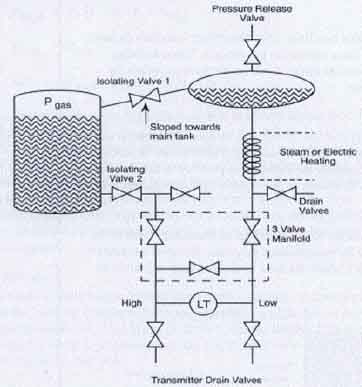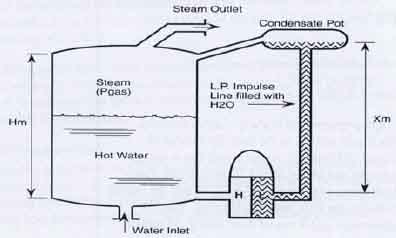In a wet leg system, the low pressure impulse line is completely filled with liquid (usually the same liquid as the process) and hence the name wet leg. A level transmitter, with the associated three-valve manifold, is used in an identical manner to the dry leg system.
Closed tank Level measurement with Wet leg system

At the top the low pressure impulse line is a small catch tank. The gas phase or vapour will condense in the wet leg and the catch tank. The catch tank, with the inclined interconnecting line, maintains a constant hydrostatic pressure on the low pressure side of the level transmitter.
This pressure, being a constant, can easily be compensated for by calibration. (Note that operating the three-valve manifold in the prescribed manner helps to preserve the wet leg.)
If the tank is located outdoors, trace heating of the wet leg might be necessary to prevent it from freezing. Steam lines or an electric heating element can be wound around the wet leg to keep to keep the temperature of the condensate above its freezing point. Note the two sets of drain valves. The transmitter drain valves would be used to drain (bleed) the transmitter only. The two drain valves located immediately above the three-valve manifold are used for impulse and wet leg draining and filling.
In addition to the three-valve manifold most transmitter installations have valves where the impulse lines connect to the process. These isolating valves, sometimes referred to as the root valves, are used to isolate the transmitter for maintenance.
Level Compensation:
It would be idealistic to say that the DP cell can always be located at the exact bottom of the vessel we are measuring fluid level in. Hence, the `measuring system’ has to consider the hydrostatic pressure of the fluid in the sensing lines themselves. This leads to two compensations required.
Zero Suppression:
In some cases, it is not possible to mount the level transmitter right at the base level of the tank. Say, for maintenance purposes, the level transmitter has to be mounted X meters below the base of an open tank.
The liquid in the tank exerts a varying pressure that is proportional to its level H on the high-pressure side of the transmitter. The liquid in the high pressure impulse line also exerts a pressure on the high-pressure side. However, this pressure is a constant (P=S.X) and is present at all times.

When the liquid level is at H meters, pressure on the highpressure side of the transmitter will be:
Phigh=S.H + S.X + Patm
Plow=Patm
P=Phigh -Plow=S.H + S.X
That is, the pressure on the high-pressure side is always higher than the actual pressure exerted by the liquid column in the tank ( by a value of S.X). This constant pressure would cause an output signal that is higher than 4 mA when the tank is empty and above 20 mA when it is full. The transmitter has to be negatively biased by a value of -S.X, only. This procedure is called Zero Suppression and it can be done during calibration of the transmitter.
Zero Elevation:
When a wet leg installation is used, the low-pressure side of the leg transmitter will always experience a higher pressure than the high pressure side. This is due to the fact that the height of the wet leg (X) is always equal to or greater than the maximum height of the liquid column (H) inside the tank.

When the liquid level is at H meters, we have:
Phigh = Pgas +S.H
Plow = P gas +S.X
P=Phigh –Plow = S.H – S.X - = -S(X-H)
The differential pressure, Δ P a negative number ( ie., low pressure side is at a higher pressure than the high pressure side). ΔP increases from P=-S.X to P=-S(X-H) as the tank level rises from 0% to 100%. If the transmitter were not calibrated for this constant negative error (-S.X), the transmitter output read low at all times.
To properly calibrate the transmitter, a positive bias (+S.X) is needed to elevate the transmitter output. This positive biasing technique is called zero elevation.